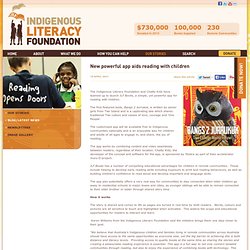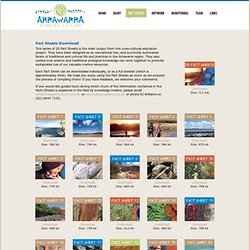

ABC Online Indigenous - Interactive Map. 1— Introduce the unit with You and Me: Our Place. Back1 1— Introduce the unit with You and Me: Our Place Leonie Norrington grew up at Barunga Aboriginal community, south of Katherine, and central to the story is the portrayal of the long-grass people who sleep out on foreshore reserves on the outskirts of Darwin.

Complete a colour, symbol and image (CSI) chart2 for the word ‘Indigenous’. Collect these to ascertain the students’ initial beliefs and knowledge about Aboriginal and Torres Strait Islander culture. Record students’ ideas in one colour so that at the end of unit, when you return to this same chart, responses can be in a different colour to provide students with a visual sense of their growth. Before reading You and Me: Our Place You and Me: Our Place cover reproduced with permission of Working Title Press As a class, look at the cover, title and end notes of You and Me: Our Place. What else is on the cover? Use on the following activities as pre-reading strategies. Indigenous Literacy - Indigenous Literacy Foundation. The Indigenous Literary Foundation and Chatty Kidz have teamed up to launch ILF Books, a simple, yet powerful app for reading with children.

The first featured book, Bangs 2 Jurrukuk, is written by senior girls from Tiwi Island and is a captivating tale which shares traditional Tiwi culture and values of love, courage and ‘One People’. The customised app will be available free to Indigenous communities nationally and is an enjoyable way for children and adults of all ages to engage in, and share, the joy of reading. The app works by combining content and video seamlessly between readers, regardless of their location.
Chatty Kidz, the developer of the concept and software for the app, is sponsored by Telstra as part of their acclelerator muru-D project. ILF Books has a number of compelling educational advantages for children in remote communities. How it works The story is shared and comes to life as pages are turned in real-time by both readers. Spiros Kotsialos of Chatty Kidz agrees. 8ways - home. Arrawarra Sharing Culture Centre - 20 Fact Sheets.
This series of 20 Fact Sheets is the main output from this cross-cultural education project.

They have been designed as an educational tool, and succinctly summarise facets of traditional and cultural life and practices in the Arrawarra region. They also outline how science and traditional ecological knowledge can work together to promote sustainable use of our valuable marine resources. Each Fact Sheet can be downloaded individually, or as a full booklet (which is approximately 9mb).
We hope you enjoy using the Fact Sheets as much as we enjoyed the process of compiling them! If you have feedback, we welcome your comments. If you would like guided tours during which much of the information contained in the Facts Sheets is explained in the field by knowledge holders, please email info@arrawarraculture.com.au or events@yarrawarra.org.au or phone EJ Williams on (02) 6640 7102.
AJCPTA - Australian Joint Council of Professional Teaching Associations. BOS - Aboriginal educational contexts. Aboriginal Perspectives Resources (with thanks to Anita Heiss) « LisaHillSchoolStuff's Weblog. As teachers know, the new Australian Curriculum includes three cross-curriculum ‘priorities’, one of which is Aboriginal and Torres Strait Islander histories and cultures.

One of the science topics includes Year 2 students identifying toys from different cultures that use the forces of push or pull, and this made me wonder about traditional Aboriginal games and whether there was a concept of a ‘toy’ in nomadic lifestyles. I’ve read a few memoirs and a quite a few children’s books by ATSI authors but I don’t recall any of them referring to this topic at all. Keen to include Aboriginal perspectives on this topic if possible, I contacted Dr Anita Heiss who is Adjunct Professor at the Jumbunna Indigenous House of Learning, at the University of Technology, Sydney. Many teachers will also know her as the author of My Australian Story: Who am I? Her most recent book is Am I Black Enough for You? Anyway, Anita generously gave her time to reply to my query with some suggested sites: